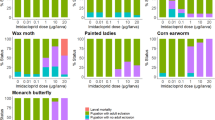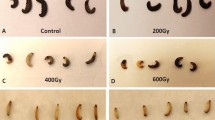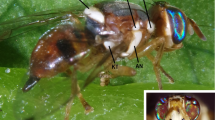Abstract
THE classical test used as the bioassay for the insect moulting hormone, ecdysone, is based on the failure of the posterior part of ligatured larvae of Calliphora erythrocephala (or other fly species) to tan unless an adequate dose of ecdysone is administered. It is crucial for the success of the test to select larvae at the right stage of development, and as closely as possible to the critical time for pupariation1. Larvae ligatured before the critical stage of natural ecdysone release may eventually pupariate in the front part where the hormone originates, but will never do so in the hind part. Post-critically ligatured larvae have had sufficient ecdysone released into the haemolymph previous to ligature to induce tanning in the hind parts. It is evident that at this time the anterior parts must also be post-critical. In larvae ligatured at this stage the anterior parts usually contract to the puparium and tan whereas the posterior parts merely tan without change in shape. The occurrence of tanning in the posterior part alone is therefore a paradox. Fraenkel2 along with the description of the “Calliphora assay” also reported that ligatured larvae occasionally tanned only in the posterior region. Several investigators have been subsequently surprised by this phenomenon of “anterior inhibition”, but there has been no agreement as to its cause.
This is a preview of subscription content, access via your institution
Access options
Subscribe to this journal
Receive 51 print issues and online access
$199.00 per year
only $3.90 per issue
Buy this article
- Purchase on Springer Link
- Instant access to full article PDF
Prices may be subject to local taxes which are calculated during checkout
Similar content being viewed by others
References
Fraenkel, G., and Zdarek, J., Biol. Bull., 139, 138 (1970).
Fraenkel, G., Proc. Roy. Soc., 118, 1 (1935).
Kaplanis, J., Tabor, L. A., Thompson, M. J., Robbins, W. E., and Shortino, T. J., Steroids, 8, 625 (1966).
Langley, P., Nature, 214, 389 (1967).
Price, G. M., Nature, 228, 876 (1970).
Chang, F., J. Insect Physiol., 16, 729 (1972).
Ohtaki, T., Milkman, R. D., and Williams, C. M., Biol. Bull., 135, 322 (1968).
Karlson, P., and Bode, C., J. Insect Physiol., 12, 111 (1969).
Ohtaki, T., Milkman, R. D., and Williams, C. M., Proc. US Nat. Acad. Sci., 58, 981 (1967).
Zdarek, J., and Fraenkel, G., Gen. Comp. Endocrinol., 17, 375 (1971).
Zdarek, J., and Fraenkel, G., J. Exp. Zool., 179, 315 (1972).
Fraenkel, G., and Herford, G. V. B., J. Exp. Biol., 15, 266 (1938).
Author information
Authors and Affiliations
Rights and permissions
About this article
Cite this article
RATNASIRI, N., FRAENKEL, G. Inhibition of Pupariation in Sarcophaga bullata. Nature 243, 91–93 (1973). https://doi.org/10.1038/243091b0
Received:
Revised:
Issue Date:
DOI: https://doi.org/10.1038/243091b0
This article is cited by
Comments
By submitting a comment you agree to abide by our Terms and Community Guidelines. If you find something abusive or that does not comply with our terms or guidelines please flag it as inappropriate.



